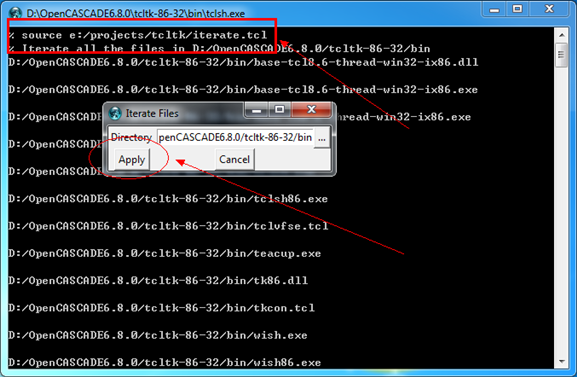Posted on 2015-01-18 12:08
eryar 閱讀(1938)
評論(0) 編輯 收藏 引用 所屬分類:
2.OpenCASCADE 、
6.Others

Iterate Files by Tcltk
eryar@163.com
Abstract. Tcl/Tk provide a programming system for developing and using graphical user interface(GUI) applications. Tcl stands for “tool command language” and is pronounced “tickle”, is a simple scripting language for controlling the extending applications. The blog use Tcl/Tk to iterate all the files for a given directory, this is useful to some automation work, such as change all the file names for a given directory; add copyright info for the source code files.
Key Words. Tcl/Tk, Iterate Files,遍歷文件夾中所有文件
1. Introduction
Tcl/Tk是一種用于易于使用的腳本語言,可以用來對程序進行擴展及完成一些自動化的工作,加上內置的一些命令,其功能要比Windows中的DOS的批處理命令功能更強大,使用更方便。Tcl腳本語言是開源免費的,可以方便獲取且免費使用。
OpenCASCADE中使用了Tcl/Tk來實現(xiàn)了一個自動化測試體系。使用在OpenCASCADE中使用自定義的Tcl命令,可以快速來檢驗算法的結果。通過編寫腳本文件,實現(xiàn)了測試的自動化。所以學習一下Tcl/Tk腳本語言,并在實際的工作中加以應用,可以將一些機械的勞動交給計算機自動完成。
本文主要說明如何使用Tcl/Tk來遍歷指定文件夾中所有文件。利用此功能,可以稍微加以擴展,就可以完成一些實際的重復勞動。如遍歷指定目錄中所有的源文件或指定類型的文件,添加上版權信息等。
2. Tcl/Tk Code
要遍歷指定目錄下所有的文件,包括子文件夾,需要用到命令glob及一個遞歸函數(shù)。腳本代碼如下所示:
#
# Tcl/Tk script to iterate all the files for a given directory.
# eryar@163.com
# 2015-01-18
#
package require Tcl
package require Tk
wm title . "Iterate Files"
label .labelDirectory -text "Directory "
entry .entryDirectory -width 30 -relief sunken -textvariable aDirectory
button .buttonDirectory -text " " -command {chooseDirectory .entryDirectory}
" -command {chooseDirectory .entryDirectory}
button .buttonApply -text "Apply" -command {perform $aDirectory}
button .buttonCancel -text "Cancel" -command {exit}
grid .labelDirectory .entryDirectory .buttonDirectory
grid .buttonApply .buttonCancel
# chooseDirectory--
# choose the directory to iterate.
#
proc chooseDirectory {theEntry} {
set dir [tk_chooseDirectory -initialdir [pwd] -mustexist 1]
if {[string compare $dir ""]} {
$theEntry delete 0 end
$theEntry insert 0 $dir
$theEntry xview end
}
}
# perform--
# perform the algorithm.
#
proc perform {theDirectory} {
puts "Iterate all the files in $theDirectory"
if {[string length $theDirectory] < 1} {
tk_messageBox -type ok -icon warning -message "Please select the directory!" -parent .
return
}
# process the iterate
process $theDirectory
}
# process--
# recursion every folder and file.
#
proc process {theFolder} {
set aFiles [glob -nocomplain -directory $theFolder *]
foreach aFile $aFiles {
if {[file isfile $aFile]} {
# just output the file name here.
# you can do something such as rename for the file.
puts "$aFile \n"
} else {
process $aFile
}
}
} 程序用法為打開Tcl解釋器,使用命令source加載腳本文件,如下圖所示:

Figure 2.1 Tcl usage
3. Conclusion
通過應用Tcl/Tk來體驗腳本編程的樂趣,并加深對Tcl/Tk的理解。從而對OpenCASCADE的模塊Draw Test Harness更好地理解。
如果有編程基礎,Tcl/Tk會很快入門的。入門后,可以應用其直接編寫一些有意思有腳本,來實現(xiàn)一些重復工作的自動化。也可將Tcl加入到自己的程序中,增加程序的二次開發(fā)功能。
可見,玩一玩腳本語言,還是非常有趣的!